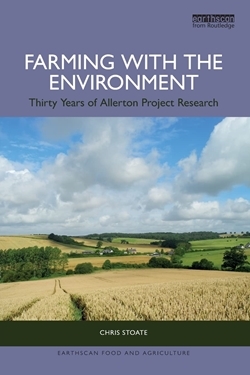By Prof. Chris Stoate, Allerton Project Head of Research
 Farmers are experiencing a period of considerable change as area payments are withdrawn, global market pressures reduce income, climate change introduces unfamiliar challenges, and new agri-environment schemes are rolled out.
Farmers are experiencing a period of considerable change as area payments are withdrawn, global market pressures reduce income, climate change introduces unfamiliar challenges, and new agri-environment schemes are rolled out.
Chapter 8 of Farming with the Environment explores these issues from the farmer’s viewpoint, based on our collaborative working with local farmers on various initiatives over the years.
Global markets determine prices received by farmers, and shocks such as Russia’s invasion of Ukraine, or climate change related impacts influence both commodity prices and input costs, independently of anything farmers can do to control them.
Importation of food produced to lower environmental or welfare standards than in the UK, and sold at lower prices, represents a major challenge for the viability of farm businesses, and for environmental standards across the world.
Climate change increasingly also affects yields. Within one decade, we experienced two years in which wheat production was reduced by 40% as a result of excessively wet autumns, for example. Droughts also take their toll.
With the loss of area payments following the UK’s departure from the EU, farmers will be increasingly reliant on Environmental Land Management scheme payments, but these are designed to cover only income forgone and management costs.
Some of the management practices supported by the Environmental Land Management scheme can contribute to food production, but our work with other research partners shows that the extent to which this applies varies considerably between farms.
Economic data from local farms also shows how farms differ in the profitability of arable crops, with for example no relationship between the level of inputs and profitability. This might be due to astute business management or agricultural expertise on the part of some farmers, but might equally be a result of variability in farm infrastructure, size, tenure, soil type, topography, etc.
Our social science research reveals how farmers learn through their participation in agri-environment schemes, and while this process is not always linear, it can result in a strengthened sense of identity with wildlife conservation and broader environmental issues, and ultimately to leaders who inspire others and encourage management at the landscape scale. We have also documented evidence that those who participate in agri-environment schemes adopt additional practices that contribute to sustainability.
There is growing awareness across the farming community of the need to improve the management of farmland, both to meet environmental objectives and to ensure the future productivity of the land to maintain food security. This can only be achieved if there is sufficient economic support to meet these societal objectives. Some of the issues associated with this are explored further in Chapter 9.